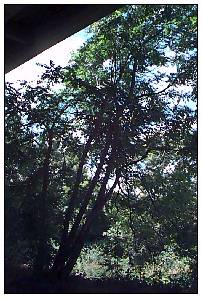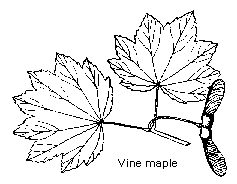 Medford Station 7: Tree of Heaven or . . . ?
Medford Station 7: Tree of Heaven or . . . ?
THIS TREE IS CALLED the tree of heaven (Ailanthus altissima). The story goes that in 1853 the Chinese cook of Abel Helman, an early Ashland pioneer, planted the first tree of heaven in this region—the very large tree that still guards the entrance to Lithia Park. This tree originates in China and can endure difficult conditions, such as drought, wind, bad soil, and freeway overpasses, to create beauty where none existed before.
It has been criticized, however, because it spreads profusely, acting like a weed. When crushed, the leaves produce an unpleasant odor. The tree of heaven also produces a chemical that retards the growth of plants with which it comes into contact.
Right behind you are a couple of vine maples (Acer circinatum), one of only three species of maples native to the northwest. Their leaves have seven to nine pointed lobes with sawtooth edges, similar to a Japanese maple. They grow in the moist shaded woods of the northwest. They flourish on second growth forest as well, and are preferred forage for deer and elk. Early explorers cursed vine maples because they grow into such a tangled thicket that they make some places all but impassable. They redeem themselves in the fall, however, when their leaves turn the brightest red of any tree in the northwest forest.



















